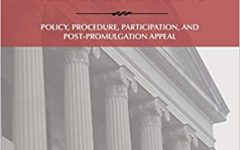
California Rulemaking Law Under The Administrative Procedure Act. (Photo: OAL.ca.gov)
Determining Whether Agency Action Is a Regulation
These formal actions can add, amend or repeal regulations
By Chris Micheli, October 27, 2021 2:24 am
California’s Administrative Procedure Act (APA) sets forth the process for executive branch administrative agencies to promulgate regulations. These formal actions can add, amend or repeal regulations that are contained in the Code of California Regulations. As a threshold matter, one needs to determine whether the proposed action by a state rulemaking body is actually a regulation.
So, what is a “regulation” for purposes of the APA? According to Government Code Section 11342.600, “regulation” means every rule, regulation, order, or standard of general application or the amendment, supplement, or revision of any rule, regulation, order, or standard adopted by any state agency to implement, interpret, or make specific the law enforced or administered by it, or to govern its procedure.
How have the California courts interpreted the term regulation and what sorts of actions taken by an executive branch agency constitute a regulation?
According to an appellate court, the APA defines “regulation” very broadly to include every rule, regulation, order, or standard of general application adopted by any state agency to implement, interpret, or make specific the law enforced or administered by it, or to govern its procedure, except one that relates only to the internal management of the state agency. Savient Pharmaceuticals, Inc. v. Department of Health Services (2007) 146 Cal.App. 4th 1457
To begin, in order to be deemed a “regulation” subject to the APA, an agency must intend its rule to apply generally, rather than in a specific case, but the rule need not apply universally. The rule applies generally so long as it declares how a certain class of cases will be decided. Californians for Pesticide Reform v. Department of Pesticide Regulation (2010) 184 Cal.App. 4th 887, review denied
How does a rule apply generally? A rule applies “generally” so long as it declares how a certain class of cases will be decided. A regulation subject to the APA has two principal identifying characteristics: first, the agency must intend its rule to apply generally, rather than in a specific case. Second, the rule must implement, interpret, or make specific the law enforced or administered by the agency, or govern the agency’s procedure. Morales v. California Department of Corrections and Rehabilitation (2008) 168 Cal.App. 4th 729; Delta Stewardship Council Cases (2020) 48 Cal.App. 5th 1014
Additionally, if a policy or procedure falls within the APA’s definition of a “regulation,” the promulgating agency must comply with the procedures for formalizing the regulation. This includes public notice and approval by the OAL and a regulation that substantially fails to comply with these requirements may be judicially declared invalid. County of Butte v. California Emergency Medical Services Authority (2010) 187 Cal.App. 4th 1175
What are some examples of regulatory action that did or did not constitute a regulation subject to the procedural requirements of the APA?
The regulatory action was a regulation subject to the APA because it was directed to the general class of retail off-sale liquor licensees that employed customer-operated checkout stands and because its interpretation of the Business and Professions Code was not essentially rote, ministerial, or repetitive. Accordingly, the advisory was void. California Grocers Association v. Department of Alcoholic Beverage Control Board (2013) 219 Cal.App. 4th 1065
The Clinical Evaluator Handbook and Standardized Assessments Protocol is a “regulation” within the meaning of Government Code Section 11342.600 even though it leaves up to an evaluator’s independent professional judgment whether or not an individual meets the sexually violent predator criteria. A determination by the Office of Administrative Law that language in the protocol constitutes a regulation was entitled to deference. Macy v. Superior Court (2012) 206 Cal.App. 4th 1393
Where the challenged policy goes beyond merely prioritizing or allocating internal resources and may significantly affect others outside the agency, such a policy goes beyond the agency’s internal management and is subject to adoption as a regulation under the APA. Center for Biological Diversity v. Department of Fish and Wildlife (2015) 234 Cal. App. 4th 214; Missionary Guadalupanas of Holy Spirit, Inc. v. Rouillard (2019) 251 Cal.Rptr. 3rd 1, review denied
Appendix A of the Delta Plan adopted pursuant to the Sacramento-San Joaquin Delta Reform Act of 2009 did not constitute an unlawful regulation under the APA because it did not fall within the definition of a “regulation” under the APA, given that it did not contain a written statement of policy (i.e., a substantive standard) that Delta Stewardship Council intended to apply generally that predicted how the Council would decide whether a proposed covered action involving conveyance complied with the Delta Plan, not did it amount to an interpretative regulation. It did not clarify an existing substantive standard articulated in the Delta Reform Act that the Council was called upon to administer. Delta Stewardship Council Cases (2020) 48 Cal.App. 5th 1014
This determination of what is or is not a regulation will determine whether the formal APA rulemaking process will need to be followed by the executive branch agency or not.
- Remote Marriage Licenses in California - July 27, 2025
- Legislative Policy on Bay Area Pilotage - July 26, 2025
- Small Craft Harbors and Waterways in California - July 25, 2025







